 The OG's Favorite Firearms
The OG's Favorite Firearms  The OG's Favorite Firearms
The OG's Favorite Firearms
Page 2
 Beretta M-34 pistol
Beretta M-34 pistol 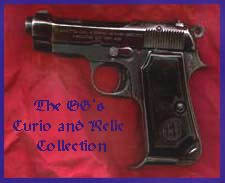
Calibre .380
And a wonderful firearm it is.
Built from 1934 (ergo ''Model 34'') through World War II, certain of these Beretta of Italy models were pressed into service as Officers' sidearms for the German army.
Mine is apparently an Italian Air Force pistol that was supplied to the German Army. My father brought it back from Europe with him after WWII. Many thanks to David Franchi for identifying the many profmarks for me!
I have found a source for 1942 Lapua Finnish 9mm short (.380) ammo, and you will frequently find me popping '42 ammo out of my '41 pistol with fair accuracy out to about 12 yards. After that, the accuracy curve drops off quickly. It is, afterall, a .380 intended for close-quarter use.
While some deride the .380 as little more than a
glorified .32, many law enforcement officials recognize the
calibre as an excellent self-defence calibre. They are
small-frame firearms which leave no unsightly bulge for the
Concealed Carry Permit Holder. The calibre (aka 9mm short) is 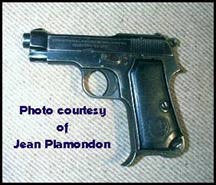 also large enough to do what needs done
within the normal distance of such situations. (Statistically,
your average firearms defense incident occurs within a range of
10 FEET and involves three shots.) It is also not so stout a
calibre that it tears through the bad guy and three houses before
it lodges in somebody (or their property) 2 blocks away.
also large enough to do what needs done
within the normal distance of such situations. (Statistically,
your average firearms defense incident occurs within a range of
10 FEET and involves three shots.) It is also not so stout a
calibre that it tears through the bad guy and three houses before
it lodges in somebody (or their property) 2 blocks away.
And, it was certainly good enough as such for the German military...
Saiga shotgun
 And
this is just what every homeowner needs for the wife. (That's
just an excuse if she's a better shot than you are). To the left,
Vanna is holding a delightfully delicate Saiga .410 shotgun,
which is basically an AK47 semi-auto shotgun which will carry up
to five rounds in the detachable magazine. It offers all of the
features that have made the Kalashnikov AK47 the housewife's
favorite in ALL of the trendy ComBloc communities AND the Big
Boot of a shotgun. These are current-production items (non
C&R). The pistol-grip stock is available only to Law
Enforcement, however, (I believe) the tasteful Monte-Carlo stock
variety qualifies as a fit ''sporting purposes'' item to fit any
home decor. Not available in New Jersey. Pink rubber buttpiece
must be custom made. Also available in .12 and .20 gauge for the
brawnier Natasha.
And
this is just what every homeowner needs for the wife. (That's
just an excuse if she's a better shot than you are). To the left,
Vanna is holding a delightfully delicate Saiga .410 shotgun,
which is basically an AK47 semi-auto shotgun which will carry up
to five rounds in the detachable magazine. It offers all of the
features that have made the Kalashnikov AK47 the housewife's
favorite in ALL of the trendy ComBloc communities AND the Big
Boot of a shotgun. These are current-production items (non
C&R). The pistol-grip stock is available only to Law
Enforcement, however, (I believe) the tasteful Monte-Carlo stock
variety qualifies as a fit ''sporting purposes'' item to fit any
home decor. Not available in New Jersey. Pink rubber buttpiece
must be custom made. Also available in .12 and .20 gauge for the
brawnier Natasha.
I am not a major Swedish Mauser fan (yet), but if you are, try here for what I found to be an interesting Swedish Mauser article
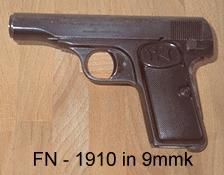
 FN-Browning
m10/22
FN-Browning
m10/22
Calibre .380
This is an intriguing pistol with an interesting background. Based on the Model 10 of 1910, the Model 22 (first production 1922) was available in .32 and .380 calibre. The m10 and m22 were extremely popular sidearms in Europe, both as civilian and military/police sidearms.
They were originally introduced into the U.S.
commercial market in 1954 as the ''Browning .380 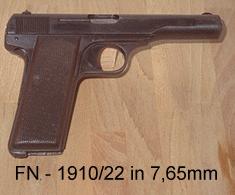 Calibre
Automatic Pistol'' and continued to be imported (in original
civilian configuration) until 1971. The Browning m22 failed to
measure up to standards established under the U.S. Gun Control
Act of 1968 and so was re-designed by FN in Belgium. It became
the ''Browning .380 pistol'' for U.S. consumption in 1971 after
being made slightly larger and weightier and being fitted with
target-style sights.
Calibre
Automatic Pistol'' and continued to be imported (in original
civilian configuration) until 1971. The Browning m22 failed to
measure up to standards established under the U.S. Gun Control
Act of 1968 and so was re-designed by FN in Belgium. It became
the ''Browning .380 pistol'' for U.S. consumption in 1971 after
being made slightly larger and weightier and being fitted with
target-style sights.
Mine is a 1934 Dutch military, second-contract model in .380 calibre.
1919 Mauser m1910
''Vest-pocket pistol''
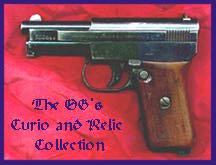 6.35mm (.25 calibre)
6.35mm (.25 calibre)
This is one, I honestly never expected. Like many of us, I
suppose, I was of the ''Friends don't let friends carry
mouse-guns'' philosophy and had drawn the line at .380calibre.
Didn't want anything smaller. Didn't even want to look at
anything smaller.
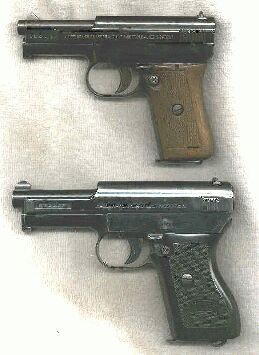 To
make a long story short, I went out to do some ''hoss trading''
one morning and the trade I wanted to make fell through. On a
whim, I stopped into a pawnshop down the road, and the manager
(who knows my taste in firearms) pulled this one out of the case.
I had to have it just on spec-- and he even took the piece I was
willing to trade as part of our deal.
To
make a long story short, I went out to do some ''hoss trading''
one morning and the trade I wanted to make fell through. On a
whim, I stopped into a pawnshop down the road, and the manager
(who knows my taste in firearms) pulled this one out of the case.
I had to have it just on spec-- and he even took the piece I was
willing to trade as part of our deal.
According to my friend BobG, citing the book Mauser Pocket
Pistols 1910-1946 by Roy G. Pender III, Mauser produced this
pistol from 1910-1914. They ceased production during World War I
to concentrate production on the m1896/9mm and the m1914/7.65mm
for the War effort. Production ceased at serial nr 152,000 and
resumed again in 1919 with serial nr 200,000. (Mine is an sn
230,xxx; which leads me to date it at 1919 manufacture.)
Production of the m1910 ceased in 1934 at sn 400,000 to be
replaced by the 7.65 (.32calibre) m1910/34.
The lower photo, courtesy of Robert
Beard, shows a m1910 at top and its
successor m1910/34 beneath.
Here is an interesting page about vestpocket pistols from Germany, Hungary, France, Switzerland and Belgium. It is an incredibly well-organized site with photos, breakdown photos and an excellent history on each of MANY small ''gentleman's pistols.''
Hungarian pistols
 Somehow or another, I seem to
have become interested in Hungarian firearms. I think it all
started when I stumbled across a Frommer STOP at one of
the local pawnshops.
Somehow or another, I seem to
have become interested in Hungarian firearms. I think it all
started when I stumbled across a Frommer STOP at one of
the local pawnshops.
Manufactured by Femaru-Fegyver es Gepgyar (FEG) in Budapest, the Frommer STOP (right) is an interesting oddity, being a long-recoil handgun in a caliber which really doesn't require such a stout system of function.
Designed by Rudolf Frommer, the S.T.O.P. was originally developed in 7.65 caliber (.32acp). It's original design was adopted as the Pisztoly 12M during 1912 for the Honved -- Hungary's contribution to the Austro-Hungarian Empire's reserve forces. In various forms, they were manufactured and used in the Hungarian Armed Forces from 1912 until 1945. There were some Pisztoly 12Ms produced in 9mm short (.380) caliber during World War I, however, the vast majority of production was in the 7.65 cal.
Production of the second "S.T.O.P." variant began in 1919 and was exclusively in 7.65 caliber. They are marked FEGYVERGYAR - BUDAPEST * FROMMER - PAT. STOP. CAL. 7.65m/m (.32).
The S.T.O.P. Pisztoly 19M was also adopted and used as the official Hungarian Army sidearm and continued in production until 1939.
The final variant of the STOP, the Pisztoly 39M was in 9mm short (.380) caliber but was not adopted as a service pistol.
What makes the STOP a rather odd duck is the design of the complex long-recoil system. Unlike most semi-automatic pistols, the "slide" doesn't slide. As a matter of fact, there really is no slide. The bolt body is connected to a long recoil rod at the rear breech-block. Upon firing, the recoil spring forces the bold body (firing pin, extractor and all) backward until the ejection-port is clear. Thereupon, the ejector throws the spent shell and a new round is chambered. The solid, slideless barrel topped by a smaller cylinder for the recoil rod give the Frommer STOP a sort of Flash Gordon raygun look that is really pretty cool.
The STOP is an accurate weapon, however the sights are extremely small. The small sights and the slight caliber make these more of a point-and-shoot, close-quarter defensive pistol as opposed to a readily-targeted competition shooter.
The STOP has a length of almost 7 inches (165mm) with a 4-groove right-twist barrel of not quite 4 inches (95mm). It weighs a bit over 1.5 lb. (0.61kg) empty. The magazine is a 7-round detachable box. The 7.65mm (.32cal) develops a muzzle velocity of approximately 920fps.
 During
the Inter-War years, the STOPs shared their military-sidearm
status with two other firearms, the FEG Pisztoly 29M
(right) and the Pisztoly 37M. Some older references indicate that
the 29M and the 37M were primarily 7.65cal firearms with some of
each made in 9mm short. Other and newer references, however, seem
to indicate that the 29M and
the 37M were mainly .380s.
During
the Inter-War years, the STOPs shared their military-sidearm
status with two other firearms, the FEG Pisztoly 29M
(right) and the Pisztoly 37M. Some older references indicate that
the 29M and the 37M were primarily 7.65cal firearms with some of
each made in 9mm short. Other and newer references, however, seem
to indicate that the 29M and
the 37M were mainly .380s.
According to some fine research by Bill Utterback as
posted on the c-r-ffl bulletin board, "The following books say the 29M
and 37M (not German) were 9mm only: Pistols
of the World by Hogg and Weeks (1992)
Handguns of the World
by Ezell (1981)
Standard Catalog of Firearms
by Schwing and Houze (1994)
Military Small Arms of the Twentieth Century
by Hogg and Weeks (1973) says the 29M was 9mm and the Hungarian
37M was both 9mm and 7.65mm. They seem to have changed
their opinion in the later 1992 book above by the same authors.
Blue Book of Gun Values
by Fjestad (1994) totally blew it. It shows no 29M at all
and says the 37M was 7.65mm only.
Take your pick, I guess.
My 37M is 9mm and so is every one (not German) that I've seen
advertised."
The 9short (.380cal) was a popular chambering for East-European paramilitaries at the time.
Both the Pisztoly29M and the Pisztoly 37M are standard blow-back operated semi-autos.
The 29M is marked as FEGYVERGYAR - BUDAPEST 29M on the slide.
A number of the 37Ms were made for the Wehrmacht during the German Occupation of Hungary in WWII. These were designated the Pistolen 39(u) and are marked P. MOD 37 KAL 7.65 on the left of the slide. The Hungarian 37Ms are marked FEMARU-FEGYVER ES GEPGYAR PT37M.
The German 37(u) can also be distinguished by the presence of a thumb- operated safety at the rear of the frame. The STOPs, the 29M and the 37M all have grip safeties.
Link here to an article on the Frommer STOP by Dennis Riordan, including disassembly instructions and exploded-view drawing.
Let's go Home Favorite
Firearms Favorite Firearms2 Firearms FAQ Index Curio'n
Relix FAQ
This page hosted by ![]() Get your own Free Home Page
Get your own Free Home Page
7/10/99